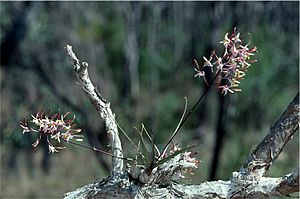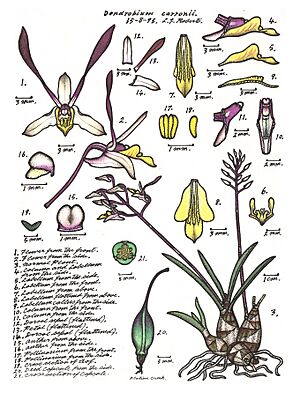Pink tea tree orchid facts for kids
Quick facts for kids Pink tea tree orchid |
|
|---|---|
 |
|
| Dendrobium carronii in the McIlwraith Range | |
| Conservation status | |
| Scientific classification | |
| Genus: |
Dendrobium
|
| Species: |
carronii
|
| Synonyms | |
|
|
The pink tea tree orchid (scientific name: Dendrobium carronii) is a small and beautiful orchid. It's an epiphyte, which means it grows on other plants, like trees, but doesn't harm them. This special orchid belongs to the family called Orchidaceae.
This orchid has interesting cone-shaped or onion-shaped parts called pseudobulbs. It usually has two to four leaves that are green or purplish. Its flowers are star-shaped and pink, with cool dark brown and purple patterns. You can find this orchid growing in tropical North Queensland in Australia and also in New Guinea.
Contents
What Does the Pink Tea Tree Orchid Look Like?
The pink tea tree orchid is a type of herb that grows on other plants. It has special parts called pseudobulbs, which are like swollen stems that store water and nutrients. These pseudobulbs are shaped like cones or onions and are about 30 to 50 millimeters (1.2 to 2.0 inches) long and 20 to 30 millimeters (0.79 to 1.2 inches) wide.
Each pseudobulb has two to four leaves on top. These leaves are green to purplish, feel a bit fleshy, and have a channel or groove down the middle. They are usually 70 to 120 millimeters (2.8 to 4.7 inches) long and about 5 millimeters (0.20 inches) wide.
When the orchid flowers, it grows a stem that is 80 to 200 millimeters (3.1 to 7.9 inches) long. This stem can hold between two and twelve pink flowers. The flowers are star-shaped and have dark brown and purple markings. Each flower is about 20 to 25 millimeters (0.79 to 0.98 inches) long and 18 to 25 millimeters (0.71 to 0.98 inches) wide.
The flower has parts called sepals, which are like small leaves that protect the bud. These are about 4 to 5 millimeters (0.16 to 0.20 inches) long. The petals are lance-shaped (like a spearhead) and are longer, about 15 to 20 millimeters (0.59 to 0.79 inches) long. Their tips are often a bit twisted. The special lower petal, called the labellum, is yellow and has three parts or lobes. The side lobes stand upright, and the middle lobe is pointed with three small ridges. This orchid usually blooms between August and October.
How the Pink Tea Tree Orchid Got Its Name
The scientific name Dendrobium carronii was officially given to this orchid in 1982. It was first described by two botanists, Bill Lavarack and Phillip Cribb. They published their description in a science journal called Austrobaileya.
The second part of its scientific name, carronii, is a special way to honor someone. It was named after William Carron (1823–1876). He was a botanist who joined an important expedition in 1848 led by Edmund Kennedy.
Where the Pink Tea Tree Orchid Lives
The pink tea tree orchid usually grows in open forests where the trees are not very tall. These areas are often found near places that get flooded during the wet season. You can often spot this orchid growing on Melaleuca viridiflora trees, which are also known as broad-leaved paperbark trees.
This orchid can be found in a few specific places. In Australia, it grows from Bamaga, which is at the very tip of the Cape York Peninsula in Queensland, all the way down to the McIlwraith Range. It also grows along the southern coast of New Guinea.
Protecting the Pink Tea Tree Orchid
The Australian Government considers the pink tea tree orchid to be a "vulnerable" species. This means it is at risk of becoming endangered if we don't protect it. This status is given under a law called the Environment Protection and Biodiversity Conservation Act 1999.
The biggest problem for this orchid is that people sometimes collect the plants illegally. This means they take the orchids from their natural homes without permission, which can harm the wild populations. Protecting these plants helps make sure they can continue to grow and thrive for future generations.



